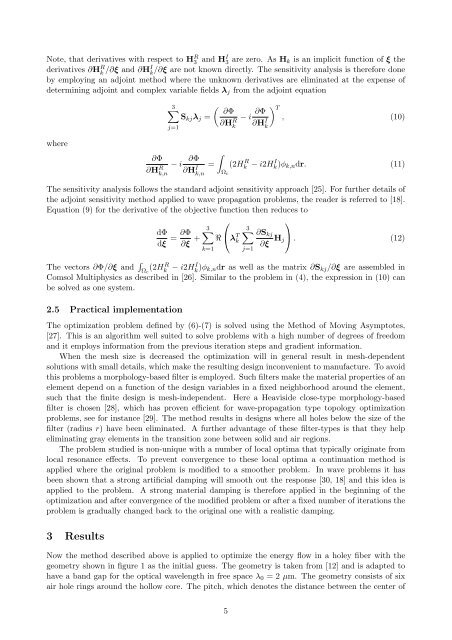Maria Bayard Dühring - Solid Mechanics
Maria Bayard Dühring - Solid Mechanics
Maria Bayard Dühring - Solid Mechanics
You also want an ePaper? Increase the reach of your titles
YUMPU automatically turns print PDFs into web optimized ePapers that Google loves.
Note, that derivatives with respect to HR 3 and HI3 are zero. As Hk is an implicit function of ξ the<br />
derivatives ∂HR k /∂ξ and ∂HI k /∂ξ are not known directly. The sensitivity analysis is therefore done<br />
by employing an adjoint method where the unknown derivatives are eliminated at the expense of<br />
determining adjoint and complex variable fields λj from the adjoint equation<br />
where<br />
∂Φ<br />
∂H R k,n<br />
3<br />
<br />
∂Φ<br />
Skjλj =<br />
j=1<br />
− i ∂Φ<br />
∂H I k,n<br />
<br />
=<br />
∂H R k<br />
Ωc<br />
− i ∂Φ<br />
∂HI T , (10)<br />
k<br />
(2H R k − i2HI k )φk,ndr. (11)<br />
The sensitivity analysis follows the standard adjoint sensitivity approach [25]. For further details of<br />
the adjoint sensitivity method applied to wave propagation problems, the reader is referred to [18].<br />
Equation (9) for the derivative of the objective function then reduces to<br />
⎛<br />
⎞<br />
dΦ<br />
dξ<br />
= ∂Φ<br />
∂ξ +<br />
3<br />
ℜ<br />
k=1<br />
⎝λ T k<br />
3<br />
∂Skj<br />
∂ξ<br />
j=1<br />
Hj<br />
⎠ . (12)<br />
The vectors ∂Φ/∂ξ and <br />
Ωc (2HR k − i2HI k )φk,ndr as well as the matrix ∂Skj/∂ξ are assembled in<br />
Comsol Multiphysics as described in [26]. Similar to the problem in (4), the expression in (10) can<br />
be solved as one system.<br />
2.5 Practical implementation<br />
The optimization problem defined by (6)-(7) is solved using the Method of Moving Asymptotes,<br />
[27]. This is an algorithm well suited to solve problems with a high number of degrees of freedom<br />
and it employs information from the previous iteration steps and gradient information.<br />
When the mesh size is decreased the optimization will in general result in mesh-dependent<br />
solutions with small details, which make the resulting design inconvenient to manufacture. To avoid<br />
this problems a morphology-based filter is employed. Such filters make the material properties of an<br />
element depend on a function of the design variables in a fixed neighborhood around the element,<br />
such that the finite design is mesh-independent. Here a Heaviside close-type morphology-based<br />
filter is chosen [28], which has proven efficient for wave-propagation type topology optimization<br />
problems, see for instance [29]. The method results in designs where all holes below the size of the<br />
filter (radius r) have been eliminated. A further advantage of these filter-types is that they help<br />
eliminating gray elements in the transition zone between solid and air regions.<br />
The problem studied is non-unique with a number of local optima that typically originate from<br />
local resonance effects. To prevent convergence to these local optima a continuation method is<br />
applied where the original problem is modified to a smoother problem. In wave problems it has<br />
been shown that a strong artificial damping will smooth out the response [30, 18] and this idea is<br />
applied to the problem. A strong material damping is therefore applied in the beginning of the<br />
optimization and after convergence of the modified problem or after a fixed number of iterations the<br />
problem is gradually changed back to the original one with a realistic damping.<br />
3 Results<br />
Now the method described above is applied to optimize the energy flow in a holey fiber with the<br />
geometry shown in figure 1 as the initial guess. The geometry is taken from [12] and is adapted to<br />
have a band gap for the optical wavelength in free space λ0 = 2 µm. The geometry consists of six<br />
air hole rings around the hollow core. The pitch, which denotes the distance between the center of<br />
5
















